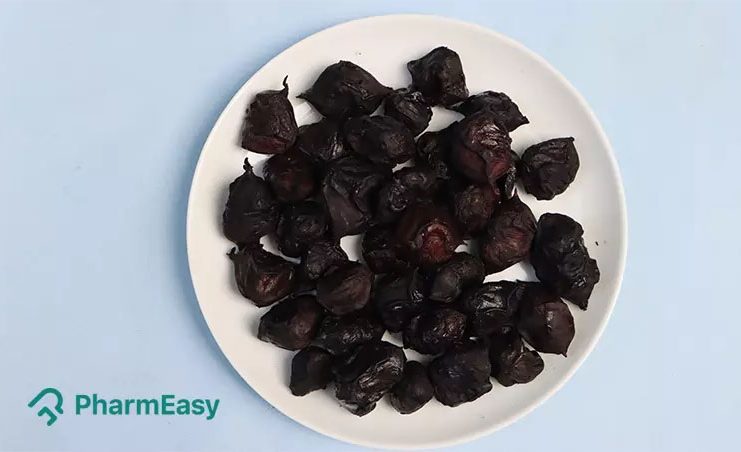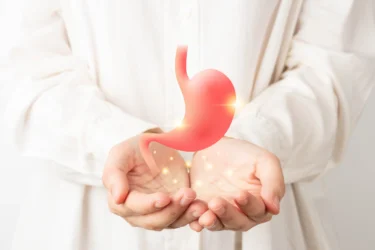Singhara (Water Chestnut): Uses, Benefits, Side Effects By Dr. Smita Barode
By Dr Smita Barode +2 more

Get,

to manage your symptom
Get your,


4 Cr+ families
benefitted

OTP sent to 9988776655



You’ve successfully subscribed to receive
doctor-approved tips on
Whatsapp

Get ready to feel your best.

Hi There,
Download the PharmEasy App now!!


Register to Avail the Offer
Send OTPBy continuing, you agree with our Privacy Policy and Terms and Conditions

Hi There,
Sign up on PharmEasy now!!
Trusted by 4 crore+ families

OTP sent to 9988776655



You have unlocked 25% off on medicines




Code: NU25
By Dr Smita Barode +2 more
Table of Contents
Singhara is one fruit that may not be your favorite, but you still see it in your house on multiple occasions. Along with the arrival of the winter season, this fruit starts to make a place in our houses and hearts! Some people use dried and powdered seeds as flour, while many like to consume them raw. The powder is also used in fasting meals.

So, if you are curious about the properties and benefits of eating singhara, you have come to the right place! Singhara in English is called water chestnuts and are fruits grown in ponds. Singhara are scientifically known as Trapa natans, belonging to the Lythraceae family. Some common names of this fruit are singhara or simkhata in Hindi, karimbolam or vankottakkaya in Malayalam, and water chestnuts in English1. Singhara is a commonly used fruit in India. In addition, Singhara has been cultivated commercially by countries like India, China, Korea, Japan, and North America2. Singhara has good nutritional value along with many beneficial properties.
The nutritional value of singhara per 100g of serving is given below.
The many properties of Singhara are given below.
Because of its good nutritional value and properties, Singhara may show potential use against many health conditions. However, more studies and research needed to consolidate the effectiveness of singhara in these conditions. That’s why you must consult your healthcare provider and get a proper diagnosis. Some of the potential uses of singhara are given below.

Involving optimal fibre in your diet can help you manage weight. Foods with high fibre content provide bulk, keeping you full for longer. High fibre is also known to delay the absorption of sugars and foods. All these benefits may contribute to healthy body weight5. However, if you want to reduce or manage weight, consult with a qualified dietician before making any significant changes to your diet.

A good amount of fibre might help keep the digestive system healthy. Singhara has plenty of fibre that enables you to meet daily requirements. In addition, having plenty of fibre is linked to a reduced risk of diseases like constipation and irritable bowel syndrome (IBS)5. It might also help maintain a good bowel movement. However, avoid eating singhara to cure or eliminate any digestive problems. If you have any digestive issues, you need to talk to your healthcare provider and get treated.
Based on my observations, water chestnuts or singhara have shown potential anti-ulcer properties. They may help restore the balance in the stomach by reducing acid-pepsin secretion and promoting mucus secretion, which can contribute to the management of stomach ulcers6.
Dr. Rajeev Singh, BAMS

Eating high fiber might help reduce the absorption of glucose from the stomach. This may help maintain blood glucose levels and help avoid surges in blood glucose. So, adding singhara to your diet might help manage the glucose levels in the blood5. However, if you have diabetes, you should adhere to the doctor’s advice and avoid using fruits or herbs on your own.

A high content of cholesterol in the blood can cause heart problems. This cholesterol can accumulate in the blood vessels and increase the risk of heart attacks. The high fibre content of singhara might help you lower your blood cholesterol and reduce the risk of heart problems5. However, more studies will be required to support the use of singhara for heart health. Therefore, in case of heart problems, reach out to your healthcare provider.

Singhara has plenty of gallic acids. Gallic acid is an effective anti-inflammatory agent, which may help reduce inflammation and swelling. This activity of singhara might help with inflammatory skin diseases. As per a study2 conducted by Kim et al. (2015), the singhara extract could reduce the skin damage caused by sodium lauryl sulphate (SLS), a popular ingredient in soaps and other products. However, more research and studies are required to support the use of singhara for skin problems. Therefore, if you are struggling with skin problems, talk to your skin doctor or dermatologist.
Though studies show the water chestnut benefits in various conditions, these are insufficient. More studies are needed to establish the true extent of the benefits of herbs on human health.
Based on my experience, I have observed that water chestnuts contain high levels of flavonoids, flavones, and phenols, which may constitue to their antioxidant properties. These antioxidants play a crucial role in protecting our cells from oxidative damage caused by harmful free radicals. Consuming water chestnuts may contribute to overall health and well-being6.
Dr. Siddharth Gupta, B.A.M.S, M.D (Ayu)
Singhara or water chestnut seeds are edible. However, make sure to peel the skin before use.
You must consult a qualified doctor before taking singhara or other herbal supplements. Do not discontinue or replace an ongoing treatment of modern medicine with an ayurvedic/herbal preparation without consulting a qualified doctor.
I recommend chestnut flour as a suitable option for patients with celiac disease. Chestnut flour is gluten-free, which means it does not contain the proteins that can trigger a reaction in individuals with celiac disease. Additionally, chestnut flour offers other health benefits, such as being a good source of fiber and nutrients, making it a valuable choice for those following a gluten-free diet6.
Dr. Smita Barode, B.A.M.S, M.S.
Because of its high fiber content, overeating water chestnuts might give you stomach problems. A sudden increase in dietary fibre may cause stomach pain and gas. Therefore, stick to moderate amounts and avoid overeating.
Also, before you use singhara for its effects against any condition, talk to your healthcare provider about the possible side effects associated with its use.
Also Read: Talmakhana: Uses, Benefits and Side Effects by Dr. Smita Barode
Before taking singhara for its health benefits, consult with a physician about the possible precautions associated with the use of singhara. It will help you make good choices about your health.
There is a lack of information on the interactions of singhara with other drugs and medicines. Therefore, consult your healthcare provider about possible medicine interactions if you are receiving treatment for any health condition.
Singhara might be helpful in weight management and digestion. Singhara may also be used against diseases like diabetes and skin and heart problems2,5. However, more research is required to support the use of singhara for its health benefits. Therefore if you are suffering from health issues, consult your healthcare provider and receive proper treatment.
Singhara is a rich source of fibre. Involving sufficient fibre in your diet might help you manage weight by giving a sense of fullness for a longer period. Fibre may also help reduce the absorption of glucose from the intestine5. All these factors combined may help you lower your food intake and help manage weight. However, talk to a dietician or healthcare provider if you want to lose or manage weight. They will be able to better guide you about each diet’s risks and benefits.
Eat singhara only after consulting with your doctor. Pregnant women should consult their healthcare provider before making any changes to their diet.
Singhara is high in fibre content. Suddenly increasing your fibre content excessively may give you stomach problems like abdominal pain and gas. Therefore, you should eat singhara in moderate amounts5. Also, before using Singhara for its health benefits, talk to your healthcare provider about the possible side effects associated with its use.
There are many ways to consume singhara. You can consume them raw (after peeling) or cooked. The powder of singhara seed kernel is often used as a flour substitute in cooking1. However, if you want to use singhara for its medicinal benefits, make sure you talk to a healthcare provider first before using any herbal remedy.
Disclaimer: The information provided here is for educational/awareness purposes only and is not intended to be a substitute for medical treatment by a healthcare professional and should not be relied upon to diagnose or treat any medical condition. The reader should consult a registered medical practitioner to determine the appropriateness of the information and before consuming any medication. PharmEasy does not provide any guarantee or warranty (express or implied) regarding the accuracy, adequacy, completeness, legality, reliability or usefulness of the information; and disclaims any liability arising thereof.
Links and product recommendations in the information provided here are advertisements of third-party products available on the website. PharmEasy does not make any representation on the accuracy or suitability of such products/services. Advertisements do not influence the editorial decisions or content. The information in this blog is subject to change without notice. The authors and administrators reserve the right to modify, add, or remove content without notification. It is your responsibility to review this disclaimer regularly for any changes.
Comments

Leave your comment...
You may also like
Comments